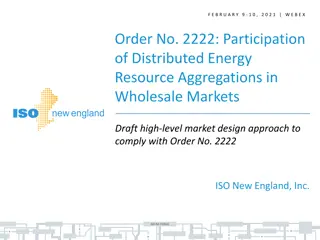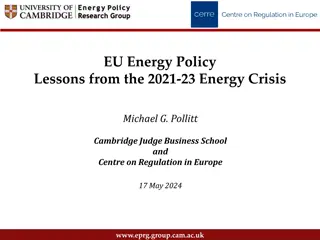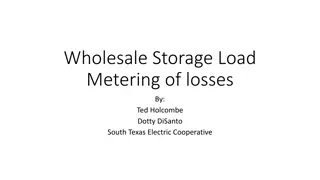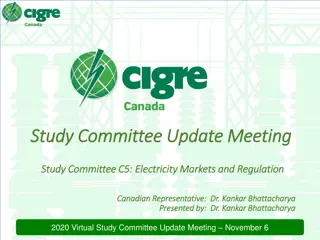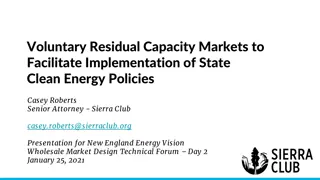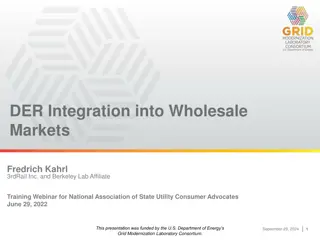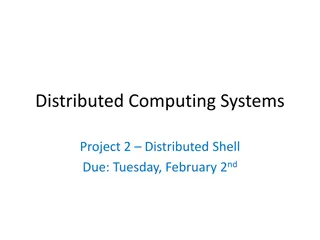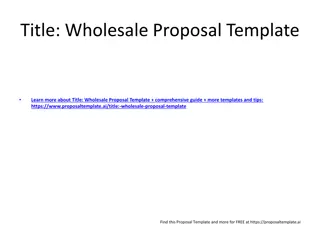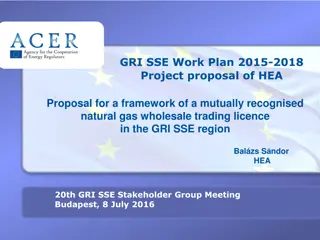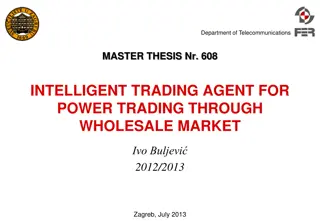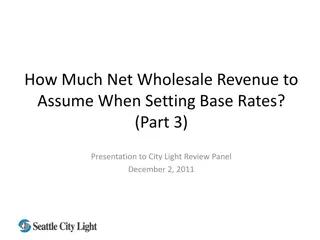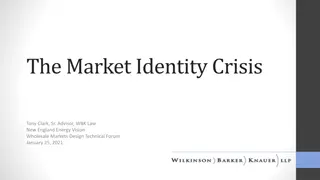Revised Approach for Distributed Energy Resource Aggregations in Wholesale Markets
Revised market design approach to comply with Order No. 2222 requires ISOs/RTOs to allow distributed energy resources to provide wholesale services. The focus is on areas like Energy and Ancillary Services Markets Participation, Metering and Telemetry Requirements, DERA Registration Coordination, and Forward Capacity Market Participation. Changes include adding a Demand Response DRDERA model and aligning requirements for aggregations with non-aggregated assets. The revised proposal aims to enhance participation and compliance in the wholesale markets.
Download Presentation

Please find below an Image/Link to download the presentation.
The content on the website is provided AS IS for your information and personal use only. It may not be sold, licensed, or shared on other websites without obtaining consent from the author. Download presentation by click this link. If you encounter any issues during the download, it is possible that the publisher has removed the file from their server.
E N D
Presentation Transcript
J U L Y 8 , 2 0 2 1 | N E P O O L M A R K E T S C O M M I T T E E W E B E X Order No. 2222: Participation of Distributed Energy Resource Aggregations in Wholesale Markets Revised market design approach to comply with Order No. 2222 Henry Yoshimura, Hanhan Hammer, Doug Smith, and Matt Gdula H Y O S H I M U R A @ I S O - N E . C O M | H H A M M E R @ I S O - N E . C O M | D L S M I T H @ I S O - N E . C O M | M G D U L A @ I S O - N E . C O M ISO-NE PUBLIC
Participation of Distributed Energy Resource Aggregations in Wholesale Markets WMPP ID: 155 Order No. 2222, issued on September 17, 2020, requires that ISOs/RTOs allow distributed energy resources (DERs) to provide all wholesale services that they are technically capable of providing through an aggregation of resources To comply, ISO/RTOs either need to: Revise their tariffs consistent with specific requirements from the Order, or Demonstrate how current tariff provisions satisfy the intent and objectives of the Order FERC has granted the ISO the February 2, 2022 compliance filing deadline ISO-NE PUBLIC 2
Todays Presentation The focus of today s presentation is the ISO s revised compliance proposal for Order No. 2222 The ISO will discuss the changes in these areas: Energy and Ancillary Services Markets Participation Metering and Telemetry Requirements DERA Registration Coordination Forward Capacity Market Participation Throughout the presentation, the ISO will respond to the recommendations presented by stakeholders at the June Markets Committee meeting ISO-NE PUBLIC 3
Overview of Changes in the Revised Compliance Proposal Energy and Ancillary Services Markets Participation Added a Demand Response Distributed Energy Resource Aggregation (DRDERA) model Expanded the existing participation models to allow for aggregations Metering and Telemetry Requirements Added metering and telemetry requirements for DRDERA model Aligned the requirements for aggregations with the existing requirements for non-aggregated assets DERA Registration Coordination Updated to align registration with updated participation models Added additional details in response to stakeholders comments Forward Capacity Market Participation Modified the overall approach to be closer to Demand Capacity Resources Completed the Forward Capacity Market design ISO-NE PUBLIC 4
ENERGY AND ANCILLARY SERVICES MARKETS PARTICIPATION Summary of changes from ISO s initial proposal ISO-NE PUBLIC ISO-NE PUBLIC 5
Changes in the Energy and Ancillary Services Markets Proposal Revised Proposal Initial Proposal Allow demand response DERs to aggregate with other types of DERs Did not allow demand response DERs to aggregate with other types of DERs Propose a Demand Response DERA (DRDERA) model to accommodate an aggregation of demand response DERs and other types of DERs Propose expanding the existing Generator Asset model (both DDP and DNE), Binary Storage Facility (BSF) model, Continuous Storage Facility (CSF) model, and Alternative Technology Regulation Resource (ATRR) model to accommodate an aggregation of DERs Except for the CSF model (see next slide), these models were not included ISO-NE PUBLIC 6
Changes in the Energy and Ancillary Services Markets Proposal (cont.) Revised Proposal Initial Proposal Propose an optional day-ahead (DA) market offer feature in the Settlement Only DERA (SODERA) model No DA market offer feature in the SODERA model A Dispatchable DERA (DDERA) is now a generic term that refers to any aggregation of DERs participating in the Generator Asset, BSF, CSF, DRR, DRDERA and ATRR models All of these participation models represent dispatchable resources Proposed a DDERA model that expanded the CSF model by allowing aggregation ISO-NE PUBLIC 7
DERA CAPABILITIES AND WHOLESALE SERVICES Four Capabilities of DERA Five Wholesale Services in the Energy and Ancillary Services Markets ISO-NE PUBLIC ISO-NE PUBLIC 8
Four Capabilities of DERA To allow for heterogeneous aggregations, the ISO s approach focuses on capabilities, not on technologies With the inclusion of demand response resource, a DER may have one or more of the following capabilities: Demand reduction capability the ability to reduce demand as measured against a baseline Energy injection capability the ability to inject energy to the grid Energy withdrawal capability the ability to withdraw energy from the grid Regulation capability the ability to balance the grid every 4 seconds If a DER has multiple capabilities, a DER Aggregator can sign up any of its capabilities and participate in the wholesale markets via a DERA ISO-NE PUBLIC 9
DERA Examples Capabilities 100 Houses A Standalone Battery Demand Reduction Houses can turn off EV chargers to reduce load against a baseline Battery can stop charging to reduce load against a baseline Energy Injection Rooftop solar injects energy Battery injects energy Energy Withdrawal Houses consume energy Battery consumes energy Regulation The smart controls at these houses can regulate Battery can regulate Aggregator A may sign up houses demand reduction and battery s demand reduction and energy injection Aggregator B may sign up houses energy injection Aggregator C may sign up houses energy withdrawal and battery's energy withdrawal Aggregator C is a Load Serving Entity Aggregator D may sign up houses regulation and battery s regulation ISO-NE PUBLIC 10
Five wholesale services are acquired through Energy and Ancillary Service Markets Wholesale Services Price Quantity Demand reduction LMP Calculated by the ISO as the difference between the Revenue Quality Meter (RQM) value measured at RDP/POI and an established baseline during the dispatched intervals Energy injection LMP Submitted by the meter reader as positive RQM value measured at the RDP/POI Energy withdrawal LMP Submitted by the meter reader as negative RQM value measured at the RDP/POI Reserves Reserve Clearing Prices Designated by the ISO Regulation Regulation Clearing Prices Cleared by the ISO ISO-NE PUBLIC 11
Wholesale services are measured at POI or RDP Point-of-Interconnection (POI) is the location to measure wholesale services provided by a DER without retail load Retail Delivery Point (RDP) is the location to measure wholesale services provided by a DER with retail load Delivery point of wholesale services is POI or RDP It can be a physical POI or RDP, or It can be a virtual POI or RDP, provided a DER s energy injection and withdrawal services are not reported as part of any other resource or load The ISO offers seven participation models for DERAs with various capabilities to provide wholesale services ISO-NE PUBLIC 12
Seven Participations Models for DERAs No. Participation Model Description A new model that enables demand response DERs to aggregate with other DERs 1 Demand Response DERA (DRDERA) A new model to settle energy at LMP 2 Settlement Only DERA (SODERA) Existing model expanded for aggregation (formerly DDERA model*) 3 Continuous Storage Facility (CSF) Existing model expanded for aggregation 4 Generator Asset (Gen Asset) Existing model expanded for aggregation 5 Binary Storage Facility (BSF) Existing model with no changes 6 Demand Response Resource (DRR) Existing model with a reduced size and a modified locational requirement Alternative Technology Regulation Resource (ATRR) 7 * The revised proposal uses the term DDERA to refer to any of the DERA participation models, except for the SODERA model. ISO-NE PUBLIC 13
PARTICIPATION MODELS DRDERA Model ISO-NE PUBLIC ISO-NE PUBLIC 14
Demand Response Distributed Energy Resource Aggregation (DRDERA) Model The ISO proposes a DRDERA model for an aggregation comprised of demand response DERs and other types of DERs Such an aggregation may have demand reduction capability, energy injection capability and energy withdrawal capability The DRDERA model leverages a majority of the market features from the existing DRR model in order to compensate demand reductions per Order No. 745 requirements Two primary differences between DRDERA model and DRR model are: DRDERA model allows other facilities in addition to end-use customer facilities to participate DRDERA model allows energy injection and/or withdrawal outside of a dispatch to be compensated and/or billed at LMPs ISO-NE PUBLIC 15
An example of DRDERA providing wholesale services A DRDERA may provide demand reduction, energy injection and energy withdrawal services in the energy markets Take a DRDERA that includes 100 houses and a battery for example: Demand reduction service is the difference between metered load and the baseline, measured from the RDPs of the houses and the POI of the battery, during ISO dispatch For example, the EV chargers at the houses and the battery stop charging Energy injection service is the energy being injected into the electric system from rooftop PV measured at the RDPs and from the battery measured at the POI Energy withdrawal service is the actual load consumed by the houses measured at the RDPs and by the battery measured at the POI Alternatively, if the DER Aggregator does not serve load, the DRDERA will not provide energy withdrawal service, and the house and battery loads will be reported by and billed to a different wholesale market participant ISO-NE PUBLIC 16
A DRDERA submits Baseline Deviation Offers A DRDERA is committed and dispatched by the ISO DRDERA is not allowed to self-schedule demand reductions for the same reasons a DRR is not allowed to self-schedule A DRDERA submits Baseline Deviation Offers, which include inter-temporal parameters and Price/MW pairs The parameters reflect how much a DRDERA can reduce demand and/or produce additional energy injection (measured as the deviation from baseline),not the amount of energy it can inject into the grid or withdraw from the grid When performing to follow a DDP, a DRDERA may inject or withdraw energy, which settles at the LMPs (details are included in a later slide) Baseline Deviation Offer is comparable to DRR s Demand Reduction Offer Baseline Deviation Offer Demand Reduction Offer Min/Max Deviation Limits Min/Max Reduction Limits Deviation Cost Reduction Cost Min Deviation Time Min Reduction Time Min Time Between Deviations Min Time Between Reductions ISO-NE PUBLIC 17
Baseline Deviation Offer prices are subject to the Net Benefit Test Price/MW pairs specify the prices at which a DRDERA is willing to deviate from baseline Prices do not reflect a willingness to supply energy to the grid, or to consume energy from the grid Per Order No. 745, subjecting Baseline Deviation Offer prices to the Net Benefit Test prevents the market from paying for demand reduction service when it provides no net benefit to load Note: demand reduction service is provided in addition to energy injection and withdrawal services, and the Net Benefits Test ensures that these additional payments, which are charged to load, are justified However, applying the Net Benefit Test in the DRDERA model does not prevent the market from paying for energy injection or billing for energy withdrawal A DRDERA is free to consume and/or inject any amount of energy (similar to a SODERA), which will be billed and/or compensated accordingly ISO-NE PUBLIC 18
A DRDERA is obligated to follow the DDP The ISO sends out a DDP requesting a DRDERA to reduce demand and/or produce additional energy injection, which the DRDERA is obligated to follow Except when the distribution utility overrides the ISO s dispatch due to safety or reliability issues Note: this is being addressed at the Transmission Committee Any penalties related to non-performance would be applied to the DERA, including non-performance related to a distribution company override (see Order No. 2222 at P312) ISO-NE PUBLIC 19
A DRDERAs performance is the sum of the performance from each DER The ISO calculates performance for each DER when the DRDERA is dispatched A DER s performance = 5-minute telemetry adjusted baseline Participant is responsible for submitting 5-minute telemetry for each DER, which is regarded as Revenue Quality Meter (RQM) data The DRDERA s performance forms the basis for DRDERA settlement, but there are differences from DRR settlement These differences will be explained on later slides The DRDERA s performance is also used: In the after-the-fact evaluation of reserves to develop a Claim10/30 cap that ensures future reserve designation is based on historical performance In the NCPC calculation ISO-NE PUBLIC 20
Baseline calculation methodology is identical to that in the DRR model The ISO calculates a baseline for each DER comprising the DRDERA using the same methodology as the existing rules in the DRR model Order No. 2222 at P118 notes that the final rule does not affect existing demand response rules Suggestions from AEE and Gridworks to reform the ISO s baseline methodology or demand response program design are not within the scope of Order No. 2222 compliance ISO-NE PUBLIC 21
The accounting for net supply is different in the DRR model and DRDERA model DRR Model DRDERA Model DRA performance= RQM adj. baseline DER performance = RQM adj. baseline DRA performance during dispatch includes two forms: demand reduction and net supply DER performance during dispatch includes two forms: demand reduction and net supply DRA demand reduction is accounted for as DRA performance capped when load reaches 0 MW DER demand reduction is accounted for as DER performance capped at when load reaches 0 MW DRA net supply is accounted for as the remainder of DRA performance, which only includes incremental net supply DER net supply is accounted for separately from DER performance. It is part of the DRDERA total net supply that is reported by the meter reader ISO-NE PUBLIC 22
DRR and DRDERA Settlement Rules Comparison DRR Settlement Quantity DRDERA Settlement Quantity Demand Reduction MWh x (1 + peak distribution loss) Calculated by the ISO Demand Reduction MWh x (1 + peak distribution loss) Calculated by the ISO During Dispatch + Incremental Net Supply + Energy Injection MWh Energy Withdrawal MWh Reported by meter reader Calculated by the ISO 0 MWh Energy Injection MWh Energy Withdrawal MWh Reported by meter reader Outside of Dispatch ISO-NE PUBLIC 23
Why account for net supply differently in the DRDERA model? Unlike the DRR model where incremental net supply is accounted for as part of each DRA s performance, net supply in the DRDERA model is accounted for separately from each DER s performance 1. This separate accounting allows energy-injecting DERs to aggregate with demand response DERs without double counting The current DRR model prevents double counting by prohibiting Gen Asset and DRR from being located at the same facility The DRDERA design eliminates that restriction 2. This separate accounting allows the DRDERA to receive payment for energy injected into the electric system outside of ISO dispatch 3. This separate accounting allows total net supply produced during dispatch to be compensated, whereas only incremental net supply is compensated under the DRR model Total net supply produced by DRDERA will be settled within the Energy Market as part of the energy supply and demand balance within each metering domain ISO-NE PUBLIC 24
An Example of DRDERA Settlement A DRDERA has two DERs: an end-use customer and a generator at separate facilities During a dispatch, it received a DDP of 4 MW The end-use customer s adjusted baseline is -2 MW (a negative value shows load); during the dispatch, its RQM is +1 MW (a positive value shows generation) The generator usually generates +1 MW to serve a local need; its adjusted baseline is +1 MW; during the dispatch, it is generating +2 MW ISO-NE PUBLIC 25
An Example of DRDERA Settlement (cont.) During a dispatch End-Use Customer Generator Adjusted baseline -2 MW 1 MW 5-minute telemetry/RQM 1 MW 2 MW DER performance 3 MW = 1 MW (-2) MW 1 MW = 2 MW 1 MW DER demand reduction 2 MW 0 MW DER net supply 1 MW 2 MW This DRDERA s performance is 4 MW, which shows it followed the DDP of 4 MW This DRDERA s settlement is 5 MW - it is compensated for 2 MW demand reduction calculated by the ISO and 3 MW energy injection reported by the meter reader The additional 1 MW in the settlement reflects compensation for total net supply ISO-NE PUBLIC 26
Other DRDERA Model Features A DER that meets the definition of Distributed Generation can participate using the DRDERA model The cost of DRDERA demand reduction will be allocated to Real- Time Load Obligation on a system-wide basis, with certain exclusions This allocation is identical to the treatment of DRRs A DRDERA is eligible to provide real-time reserves and to meet the participant s Forward Reserve Obligation When a DRDERA is not dispatched, it may be designated for offline reserves based on its Claim 10/30 value, if it is a Qualified Fast Start When a DRDERA is dispatched, it may be designated for online reserves A DRDERA s demand reduction capability and energy injection capability are eligible to qualify to supply capacity in the Forward Capacity Market ISO-NE PUBLIC 27
PARTICIPATION MODELS SODERA model Generator Asset models BSF model and CSF model DRR model and ATRR model ISO-NE PUBLIC ISO-NE PUBLIC 28
Settlement Only DERA Participation Model Settlement Only DERA (SODERA) model is an extension of Directly Metered Load Asset and Settlement Only Generator (SOG) models with aggregation If a DER Aggregator registers a SODERA, it participates as: 1. DERA SOG represents the generation portion of the resource 2. DERA Load Asset represents the load portion of the resource 3. Or both A SODERA Is not dispatchable by the ISO Must meet proposed revenue quality metering requirements May inject and/or withdraw May participate in the Forward Capacity Market May buy and sell energy in the Day-Ahead and Real-Time Energy Market Cannot provide reserves or regulation It is not dispatchable and does not provide telemetry to the ISO From February MC Material. Additions are in green. ISO-NE PUBLIC 29
SODERA Model The ISO proposes an optional DA market offer feature in the SODERA model to ensure consistent treatment between load-side of a SODERA and a Load Asset A Load Asset can buy energy at the DA market prices, so the load-side of a SODERA should have the same DA access Since SODERA can have both load and supply side, the ISO proposes that feature should be extended to the supply-side of a SODERA If the supply-side of a SODERA receives a DA award, the cleared position is paid DA LMPs, with the difference between RT and DA quantities settled at RT LMPs Unlike other supply resources that clear in the DA market, there is no commitment to run the supply-side of the SODERA in real-time SODERA can be a resource participating in the FCM Capacity Supply Obligation will be based on the generation capability of the DERs comprising the SODERA The ISO does not require a SODERA with CSO to offer in the DA market, similar to the Settlement Only Generator treatment Capacity Load Obligation will be based on the actual consumption of the DERs comprising the SODERA during the peak hour in the previous year From February MC Material. Additions are in green. ISO-NE PUBLIC 30
Expand Generator Asset models to allow for aggregation The existing Generator Asset models allow for aggregation under limited circumstances The ISO proposes expanding the Generator Asset models to accommodate a DERA with dispatchable energy injection capability A DERA will participate under either the DDP model or the DNE model. It must meet the requirements of the ISO Tariff and ISO Operating Documents that are applicable to a DDP or DNE Gen Asset ISO-NE PUBLIC 31
Expand BSF model and CSF model to allow for aggregation The existing Binary Storage Model (BSF) model and Continuous Storage model (CSF) do not allow for aggregation Current rules allow for a hybrid facility behind the same POI to use CSF model The ISO proposes expanding the BSF model and CSF model to accommodate a DERA with dispatchable energy injection and withdrawal capability and /or regulation capability It must meet the requirements of the ISO Tariff and ISO Operating Documents that are applicable to a BSF or a CSF ISO-NE PUBLIC 32
No changes are proposed for DRR Model and ATRR Model DRR model is an existing model that allows an aggregation of demand response DERs to participate in the wholesale markets No changes are proposed to the existing DRR model ATRR model is an existing model that allows an aggregation to provide regulation capacity and regulation services No changes are proposed to the model itself, with the exception of locational and size requirements described in the next section ISO-NE PUBLIC 33
LOCATIONAL AND SIZE REQUIREMENTS ISO-NE PUBLIC ISO-NE PUBLIC 34
Size Requirements Minimum size requirement is 100 kW for all participation models The ISO proposes reducing minimum size requirement of an ATRR from 1 MW to 100 kW No maximum size limit for any participation model, provided If a DER s maximum capability is 5 MW, it must be the only DER in the aggregation If a group of DERs can inject >= 5 MW at a single transmission node, this group of DERs cannot aggregate with DERs at other nodes To use the SODERA model, each DER s maximum energy injection capability must be < 5 MW and must meet the requirements to be registered as SOGs per OP-14 ISO-NE PUBLIC 35
Locational Requirements For Gen Asset, BSF, CSF, SODERA and DRDERA, the locational requirement is that all constituent DERs must be within the intersection of metering domain and DRR Aggregation Zone A common metering domain is necessary because these models settle energy injection and withdrawal For DRR and ATRR, the locational requirement is that all constituent DERs must be within the same DRR Aggregation Zone A common metering domain is not needed because these models do not settle energy injection and withdrawal DRR s locational requirement is unchanged ATRR s location requirement is newly proposed to minimize likelihood of congestion management issues ISO-NE PUBLIC 36
METERING & TELEMETRY Summary of changes from ISO s initial proposal ISO-NE PUBLIC ISO-NE PUBLIC 37
Metering and Telemetry Design Considerations Align requirements for each of the newly proposed DERA participation models with existing requirements for associated non-aggregated assets This will ensure metering equivalence between aggregated and non- aggregated resources for: The market products being bought and sold Real-time situational awareness Accuracy, precision, latency, etc. Utilization of existing meter data collection systems will also facilitate cost-efficient implementation Maintain current controls and responsibilities for submission of revenue quality interval data and telemetry, and for real time communications and security of these data Host Participant Meter Reader/Assigned Meter Reader Designated Entity/Demand Designated Entity ISO-NE PUBLIC 38
Revenue Quality Interval Metering All DERA models, with the exception of the aggregated ATRR and DRR models, participate directly in the Energy Market This includes DERAs participating under the Generator Asset, BSF, CSF, SODERA and DRDERA As such, their energy withdrawal and injections must be included in the revenue metering data reporting required of the Participating Transmission Owners under Section 3.06 (a) (x) of the Transmission Operating Agreement and Manual M-28 Revenue quality metering (RQM) must be submitted to the ISO by the Assigned Meter Reader on the same timetable as for other generator and load assets This is a daily requirement detailed in Manual M-28, to accommodate the bi-weekly settlement ISO-NE PUBLIC 39
Revenue Quality Interval Metering (cont.) If the DERA includes an associated Load Asset (pursuant to the BSF, CSF, SODERA, DRDERA models), that load must be reported as part of the RQM for the Load Asset associated with the DERA for any interval during which the aggregation has load If the DERA includes an associated Generator Asset (pursuant to the Generator Asset, BSF, CSF, SODERA, and DRDERA models), that generation must be reported as the RQM for the Generator Asset associated with the DERA for any interval during which the aggregation has generation Reported load or generation must not be included in the reported load or generation of any other Generator Asset or Load Asset ISO-NE PUBLIC 40
Revenue Quality Interval Metering (cont.) The generation and load RQM of a DERA that includes both will be reported separately (where both may be non-zero for a given interval) Maximum interval duration is 1 hour If telemetry exists reflecting the entire DERA, it may be used to profile the hourly data for sub-hourly settlement 5 minute data is optional and, if provided, will be used for sub-hourly settlement The RQM must be located at, or compensated to: Retail Delivery Point (RDP) if DER includes retail load Point of Interconnection (POI) if DER does not include retail load DER device, subject to the relevant Host Participant Meter Reader s ability to report the DER s performance to the ISO such that the DER s output or consumption does not reduce or increase the load reported at the RDP or POI ISO-NE PUBLIC 41
Response to Feedback on Device Level Metering AEE asserted that device level metering is a necessary component to the Order No. 2222 design, and has suggested that third-party meter readers be included in the design AEE notes that sub-meters are allowed for passive demand resources and that third- parties are used to report RQM and telemetry for active demand resources The data used for settling passive or active demand resources do not impact Energy Market settlement and is not subject to reporting by the Meter Readers Passive demand resources including Energy Efficiency resources, and some behind-the- meter Distributed Generation do not participate in the Energy Market Active demand resources Demand Response Resources are economically dispatched, but any payment for demand reductions are funded through mechanisms outside of the Energy Market The metered load reported by the Meter Readers for Energy Market settlement includes any demand reductions achieved by demand resources, so the measurement of and payment for demand reductions must occur outside of the Energy Market In New England, all meter reading responsibility for Energy Market assets is borne by the Participating Transmission Owners (PTOs) based on both the Transmission Owners Agreement and Manual M-28, as mentioned previously ISO is not authorized to conduct Energy Market meter reader functions or authorize the use of a third-party meter reader Any third-party meter reader would have to be authorized by the relevant PTO ISO-NE PUBLIC 42
Response to Feedback on Device Level Metering (cont.) The Participating Transmission Owners (PTOs) are responsible for providing RQM for generation, tie lines, and load PTOs have indicated that in many jurisdictions, work is proceeding to accommodate RQM that can be read daily at RDPs within the next several years They have further stated that they are not able to accommodate load reconstitution at this time Each distribution company s metering infrastructure is at a different state of maturity Cost recovery of metering infrastructure is subject to state review and approval Because of these differences across utility territories and jurisdictional issues, the ISO does not find it appropriate to mandate a specific metering approach that requires reconstitution or parallel metering of behind-the- meter DERs To the extent that a utility cannot accommodate device level metering, other options remain available: Metering at the RDP/POI Participation using the Demand Response Resource model ISO-NE PUBLIC 43
Telemetry Requirements Telemetry is meter and other data that is provided to the ISO in real time, or, in the case of the DRR model, in near real-time Telemetry representing the real-time energy injection and withdrawal of each DERA is required for the ATRR, Generator Asset, BSF, and CSF models All of these models require latency of 10 seconds (4 seconds for ATRRs and other assets providing regulation service) Telemetry requirements for the DRR model are unchanged from existing requirements <5 minute latency for 5 minute average MW data is required from all DRAs in all DRRs <1 minute latency for <1 minute (instantaneous or average) MW is required from all DRAs associated with DRRs that provide 10 minute reserves There are no telemetry requirements for the SODERA model, consistent with the ISO s rules for other settlement only resources and non- dispatchable Load Assets ISO-NE PUBLIC 44
Telemetry Requirements for DRDERA Model Like the DRR model, telemetry requirements for the DRDERA model apply to each component within the aggregation and depend on the market products offered Telemetry for each component DRA must be located at or compensated to the RDP or POI, or at the DER device if the associated revenue quality metering is also at the device OP-18 requirements for Demand Response Assets will apply Like the DRR model, telemetry latency requirement depend on the markets in which the DERA participates: Telemetry data minimum requirements for DRDERAs participating in Energy, Capacity, and thirty-minute reserve markets: Telemetered data is the average energy injection and/or withdrawal for each component of the DRDERA in each 5 minute interval Must be received by the ISO within 5 minutes of the end of each interval Telemetry data minimum requirements for DRDERAs participating in Energy, Capacity, thirty-minute reserves, and ten-minute reserves markets: Is the instantaneous or average rate of injection or withdrawal for each component in the DRDERA Must be updated at least every 1 minute ISO-NE PUBLIC 45
Response to Feedback on Telemetry Requirements AEE has suggested that the latency of telemetry for DERAs that do not provide regulation should follow the DRR model as compared with the models of dispatchable generators, BSFs, and CSFs The ISO proposal accommodates this request for DRDERAs but not for other dispatchable aggregations due to: Operator need for real-time situational awareness of the power system Real-time situational awareness is achieved by modeling the power system, and updating that model in real time using telemetry data from power system assets Currently, Generator Assets, BSFs, CSFs, and ATRRs are included in the power system model, but DRRs are not Relaxing current latency requirements decreases situational awareness and is not warranted given the increasing operational constraints of the generation fleet and need for shorter latency data The ability to leverage existing systems for data collection, validation, and evaluation of performance to minimize implementation costs Very few DRRs provide telemetry required to be designated for 10 minute reserves Among those few that do provide 10 minute reserves, their telemetry is updated every 1-3 seconds, despite requirements that they only need do so every 1 minute ISO-NE PUBLIC 46
DERA REGISTRATION COORDINATION ISO-NE PUBLIC ISO-NE PUBLIC 47
The four stages of registration Initial Notification of Intent to Register a DERA Eligibility Confirmation Registration and Activation Updates to an Existing DERA Registration From February MC Material. ISO-NE PUBLIC 48
Registration Stage 1 - Initial notification DER Aggregator simultaneously notifies ISO and DU of intent to register a DERA Include contact info and general DERA description location(s), size(s), technologies, planned markets, intended participation model, desired target date Prior to submitting the Initial Notification, each DER must have an executed interconnection agreement where state rules require the DER to have an interconnection agreement If an interconnection agreement is not required, additional DU studies may be necessary to identify distribution system impacts Desired participation target date must be at least 20 days out Initial notification establishes the 60-calendar day deadline for the distribution review registration completion, which includes: DU review for safety, reliability and eligibility, in accordance with ISO- specified criteria Plus any additional DU/state established criteria that may be put in place From February MC Material. Modifications are in green. ISO-NE PUBLIC 49
Additional information required with initial notification to support ISO & DU review Electrical interconnection information for each DER that is part of a DERA is required by the ISO Interconnection bus name Interconnection voltage level Name and number of the modeled PSS/E bus electrically closest to the interconnection point Nameplate MW / Net Injection Technology Type(s) Inverter Limit This information should be part of a DER s interconnection agreement (if one is required), but should be provided to the ISO by the DU/DER Aggregator, even if an interconnection agreement is not required The DU may seek additional information, if based on what the DER Aggregator provides, it is not able to complete its review From February MC Material. Modifications are in green. ISO-NE PUBLIC 50








